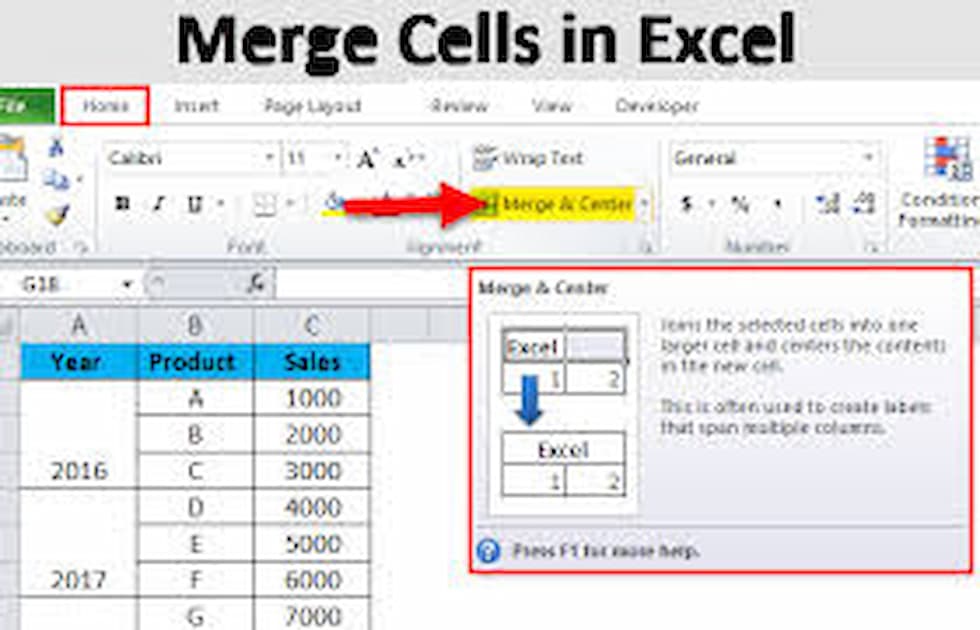Microsoft Excel is a powerful tool for data analysis and management. One of the common tasks users often need to perform is joining cells. Whether you’re looking to merge cells or concatenate their contents, this guide will provide you with step-by-step instructions on how to join cells in Excel effectively.
Why Join Cells in Excel?
Joining cells in Excel can help you organize and present your data more clearly. Here are a few reasons why you might need to join cells:
- Combining Data: Merge information from multiple cells into one cell for better readability.
- Creating Headers: Join cells to create a single header for columns or rows.
- Data Management: Simplify data by combining related information.
Methods to Join Cells in Excel
There are several methods to join cells in Excel, including using the Merge function, the CONCATENATE function, and the “&” operator. Each method serves different purposes and can be used depending on your specific needs.
1. Using the Merge Function
The Merge function is used to combine multiple adjacent cells into a single cell. This method is commonly used for formatting purposes, such as creating headers.
Steps to Merge Cells:
- Select the Cells: Highlight the cells you want to merge.
- Access the Merge Function: Go to the “Home” tab on the ribbon.
- Click Merge & Center: In the Alignment group, click “Merge & Center.” You can also choose “Merge Across,” “Merge Cells,” or “Unmerge Cells” depending on your needs.
Pros: Simple and quick for creating headers or formatting tables. Cons: Only the content of the upper-left cell is retained; other cell contents are lost.
2. Using the CONCATENATE Function
The CONCATENATE function (or CONCAT in newer versions) joins the contents of multiple cells into one cell without merging the actual cells.
Steps to Use CONCATENATE:
- Select the Target Cell: Click on the cell where you want the combined data to appear.
- Enter the Function: Type
=CONCATENATE(or=CONCAT(. - Specify the Cells: Enter the cells you want to join, separated by commas. For example,
=CONCATENATE(A1, " ", B1).
Pros: Retains the contents of all cells and allows for adding separators like spaces or commas. Cons: Requires more steps and familiarity with functions.
3. Using the “&” Operator
The “&” operator is another way to join the contents of multiple cells. It works similarly to CONCATENATE but is often considered more straightforward.
Steps to Use the “&” Operator:
- Select the Target Cell: Click on the cell where you want the combined data to appear.
- Enter the Formula: Type the formula using the “&” operator. For example,
=A1 & " " & B1.
Pros: Simple and flexible for combining text and cell contents. Cons: Requires manual entry of the formula each time.
Practical Examples
Example 1: Merging Cells for a Header
If you have a table and want to create a single header spanning multiple columns:
- Highlight the Cells: Select the cells across the columns you want to merge.
- Click Merge & Center: Use the Merge & Center function in the Home tab.
Example 2: Concatenating First and Last Names
If you have first names in column A and last names in column B and want to create a full name in column C:
- Select Cell C1: Click on cell C1.
- Enter the Formula: Type
=A1 & " " & B1or=CONCATENATE(A1, " ", B1). - Copy the Formula: Drag the fill handle down to apply the formula to other rows.
Example 3: Joining Text with Numbers
If you want to join text with numbers, such as “Total: 100”:
- Select the Target Cell: Click on the cell where you want the result.
- Enter the Formula: Type
="Total: " & A1(assuming the number is in cell A1).
Tips for Joining Cells in Excel
Use Appropriate Functions
Choose the right method depending on whether you want to merge the actual cells or just concatenate their contents.
Add Separators
When concatenating, remember to add necessary separators (like spaces or commas) for better readability.
Check for Errors
Ensure your formulas are correctly typed and reference the correct cells to avoid errors.
Use Text Functions
Combine text functions like UPPER, LOWER, and TRIM with CONCATENATE or “&” for more advanced text manipulation.
Preserve Data
Always back up your data before merging cells, as merging can sometimes lead to loss of content.
Common Questions About Joining Cells in Excel
Can I Unmerge Cells?
Yes, you can unmerge cells by selecting the merged cell and clicking “Unmerge Cells” in the Merge & Center dropdown menu.
Will Merging Cells Delete My Data?
Merging cells will keep the content of the upper-left cell and discard the rest. Use concatenation methods to preserve all data.
Can I Join Non-Adjacent Cells?
You can concatenate the contents of non-adjacent cells using CONCATENATE or the “&” operator, but you cannot merge non-adjacent cells.
Conclusion
Joining cells in Excel can help you better organize and present your data. Whether you’re merging cells for a cleaner look or concatenating cell contents for data management, understanding these methods will enhance your Excel skills. By following the steps and tips provided in this guide, you’ll be able to join cells efficiently and effectively in your spreadsheets. Happy Excel-ing!



